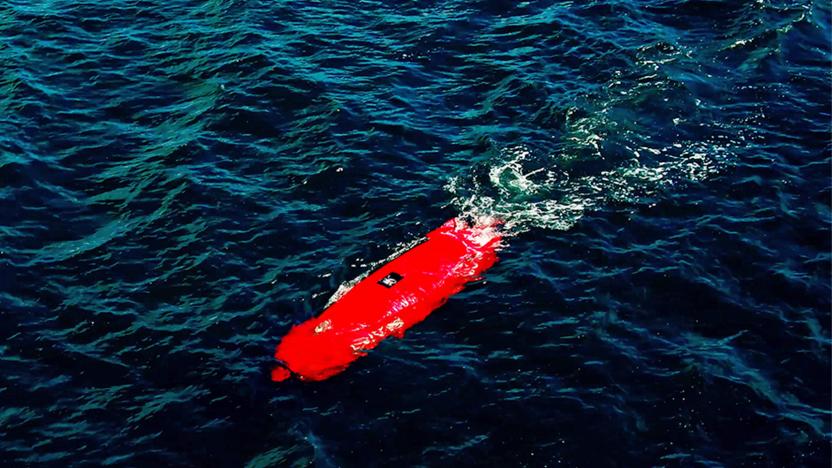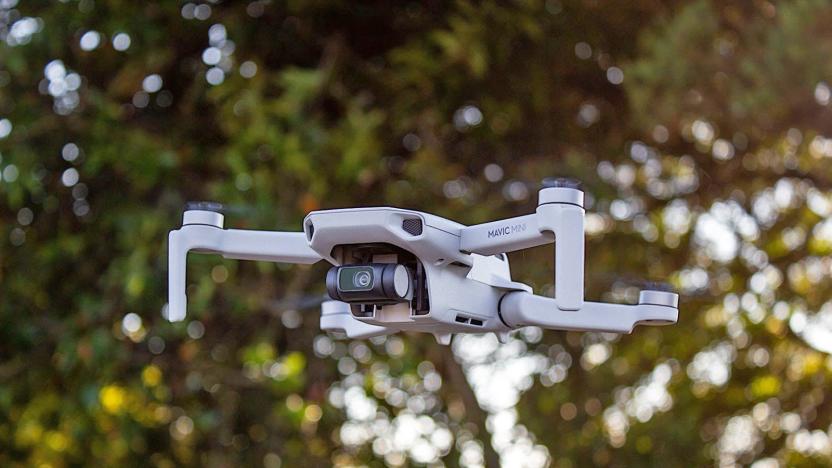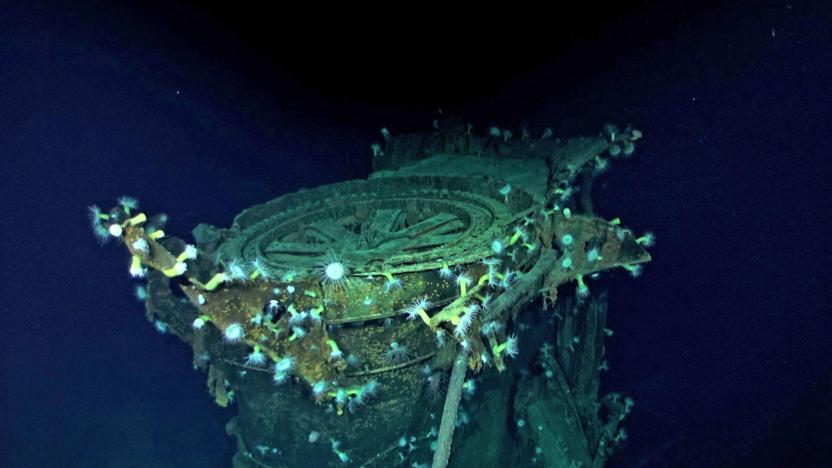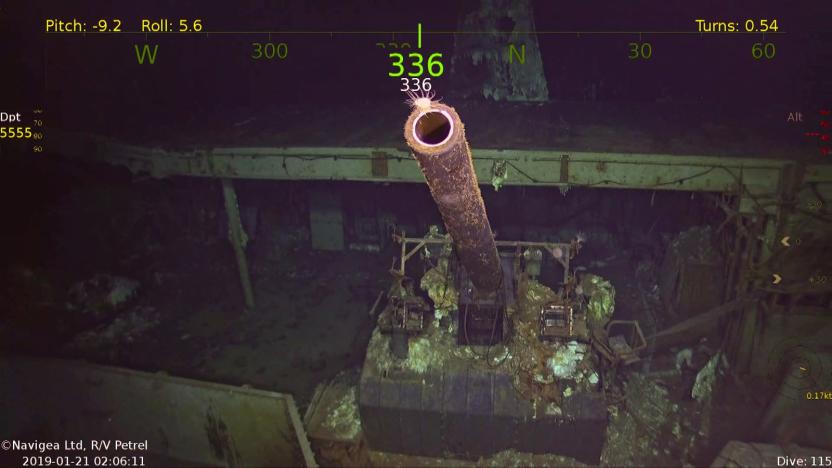AUV
Latest

Palmer Luckey's startup bought an underwater drone company
Palmer Luckey's AI defense company Anduril is expanding to underwater drones by acquiring Dive Technologies.

Drones can navigate like bats using four mics and a speaker
Bats can find their way in the dark using echolocation, so why can't drones? Researchers have managed just that. They've developed a system that lets a drone navigate using just four microphones and a speaker. It relies on the familiar concept of measuring distance by generating echoes, but uses an algorithm based on communicative algebra that 'echosorts' to determine which distances represent given objects. It won't produce "ghost walls" that leave the drone afraid to move.

Sonar drone helps find a WWII Japanese aircraft carrier
The late Paul Allen's underwater robotics are still achieving firsts in discovering long-lost warships. Vulcan's research vessel Petrel and its two robotic vehicles have discovered the Kaga, a Japanese aircraft carrier sunk during WWII's pivotal Battle of Midway. It's the first time anyone has found a Japanese carrier, Vulcan said, and also the most extensive search the Petrel team has conducted. The team spent several weeks combing an entire battlefield, covering an area of more than 500 square nautical miles -- it found the Kaga more than 17,700 feet underwater.

Sonar drone discovers long-lost WWII aircraft carrier USS Hornet
The late Paul Allen's research vessel, the Petrel, has found another historic warship at the bottom of the ocean. In the wake of an initial discovery in late January, the expedition crew has confirmed that it found the USS Hornet, an aircraft carrier that played a pivotal role in WWII through moments like the Doolittle Raid on Japan and the pivotal Battle of Midway. It was considered lost when it sank at the Battle of Santa Cruz in October 1943, but modern technology spotted it nearly 17,500 feet below the surface of the South Pacific Ocean, near the Solomon Islands.

Microsoft co-founder's remote vehicles find a legendary WWII ship
The USS Indianapolis played an important role in WWII history, including the delivery of parts for the atomic bombs that would eventually drop on Japan. However, it met a grim fate: not only did a Japanese submarine sink it near the end of the war, but its wreck has remained elusive despite multiple expeditions over the past 72 years. Technology just provided some resolution, though. A team piloting Microsoft co-founder Paul Allen's research vessel, the R/V Petrel, has found the wreck of the Indianapolis at the bottom of the Philippine Sea. The discovery was helped by a mix of better information and the equipment aboard the Petrel itself.

Undersea robots find key clue to a mysterious shipwreck
Robots just helped shed light on a maritime tragedy. The US Coast Guard, National Transportation Safety Board and Woods Hole Oceanographic have used both an autonomous underwater vehicle (AUV) and a fiber-controlled craft to find the voyage data recorder of the El Faro, a cargo ship that sank near the Bahamas during Hurricane Joaquin last October. That's no mean feat when its remains are 15,000 feet deep, and the recorder is roughly the size of a coffee can. The recovery should not only help explain the exact circumstances of the El Faro's final moments, but provide some closure to the families of the 33 crew members that lost their lives.

Autonomous robosub hunts starfish with poison-tipped needles
Crown-of-thorns starfish (COTS) are voracious coral consumers with a propensity for population explosions, which makes them very real threats to the world's coral reefs. And while they're typically held in check by fish higher in the food chain, overly aggressive human fishing has decimated these predator species. That's why a team from the Queensland University of Technology in Australia has spent the past decade developing a fully autonomous COTS-hunting robotic submarine to help bring these populations back into balance.

Robotic vehicles find the Pacific Ocean's deepest thermal vents
Robotic underwater vehicles from the Monterey Bay Aquarium's Research Institute just helped discover one of the Earth's more elusive scientific treasures. Both an autonomous mapping craft and a remotely operated counterpart (which collected video and samples) traveled 12,500 feet to the bottom of Mexico's Pescadero Basin to find the Pacific's deepest hot hydrothermal vents. The machines achieved their feat in just two days, versus the years that it'd take for conventional undersea mapping -- and they achieved the kind of detail that would likely be difficult or impossible using those earlier techniques.

France and the UK want a fleet of minesweeping robot ships
The biggest threat to America's Navy over the past 60 years hasn't been China's rapidly modernizing military, North Korea's nuclear saber rattling or even Russia's arctic overtures -- it's been underwater mines. They've damaged 15 of our ships since 1950. Sure, you can disarm these explosive hazards manually but that means risking the lives of Navy seamen in an underwater Hurt Locker. Instead, the UK and France are teaming with European defense contractors Thales and BAE to develop a fully automated minesweeping system that keeps sailors out of harm's way.

University of Victoria's Mano underwater robot to prowl Arctic waters for legendary ships
Canadians well-versed in their history are very aware of Sir John Franklin's ill-fated 1845 expedition to find the Northwest Passage: a British voyage that set out to establish a sailing route through the Arctic and ended with the untimely, mysterious deaths of its two ship crews. No human ever found the abandoned ships, which makes it all the more fitting that the next best shot at discovery might come through a just-launched autonomous underwater vehicle from the University of Victoria and Bluefin Robotics. Meet the Mano, a new sonar-toting robot that can produce detailed undersea maps all by its lonesome while keeping a steady altitude above the ocean floor. It can only operate for 12 hours at a time, which will keep humans in the area, but its ability to run untethered below storms and cold Arctic winds should dramatically expand the territory that researchers can cover during their share of a larger five- to six-week journey. There's no guarantee that the Mano will hit the jackpot, or find something recognizable even if it does. Still, any mapping should improve navigation for modern boats -- and hopefully prevent others from sharing Sir Franklin's fate.

MIT software optimizes paths for automated undersea vehicles (video)
So, there's good news and bad news. The former is that MIT researchers have developed new software and methods that can predict optimal paths for automated underwater vehicles. The latter is that it's meant to be used for "swarms" of them, "moving all at once toward separate destinations." We hate to be the folks that keep harping on the inevitable, but teaching "swarms" of undersea robots how to effectively draw paths to the very creators that made them makes us... well, less that cozy. Paranoia aside, the Pierre Lermusiaux-led team has concocted a system that can provide paths optimized either for the shortest travel time or for the minimum use of energy, or to maximize the collection of data that is considered most important. The goal? To make the lives of gliders more efficient when engaged in "mapping and oceanographic research, military reconnaissance and harbor protection, or for deep-sea oil-well maintenance and emergency response." Oh, and did we mention that it can incorporate obstacle-avoidance functions for the sake of protection. Yeah. Death from above below.

Video: MIT robofish set to snoop the deep seas
MIT has been at this robotic fish lark for a long, long time, and its latest iteration is a true testament to all the effort and energy put in. The first prototype, 1994's Robotuna, was four feet long and had 2,843 parts driven by six motors, whereas the new robofish is no longer than a foot, carries one motor and has exactly ten components, including the flexible polymer body. The hardy and relatively inexpensive drones can be used as substitutes for AUVs in tight spaces, inhospitable environments and the like, but their earliest adopters are likely to be supervillains in need of surveillance bots for their moats. Video after the break. [Via CNN]

Video: Cornell's autonomous robot sub wins competition, our hearts
Cornell sure seems to be doing its part to usher in a world where robots call the shots and humans spend most of their time cowering in the corners of bomb-out buildings. Researchers at the school have variously applied their brain matter (and we're guessing the occasional government check) to such sticky problems as robot consciousness, distance walking, and complications related to using robotics in zero gravity. And now we've heard that the school has just won something called the Autonomous Underwater Vehicle Competition. The vehicles entered in the 12th annual AUVC (which was held at the Space and Naval Warfare Systems Center in San Diego) ran an underwater obstacle course that involved bombing things, firing torpedoes, and eventually recovering a suitcase with "secret documents" (or old issues of 2600: The Hacker Quarterly, depending on who you believe). You can see the thing in action for yourself in the video after the break.[Via GoRobotics.net]

Autosub6000 to explore deep undersea volcanoes as only a robot could
The UK's National Oceanography Center in Southampton is prepping to launch a new autonomous underwater vehicle (also known as a robo-sub, landlubber) capable of exploring undersea volcanoes in the Cayman Trough up to 20,000 feet deep. It'll only run for about a kilometer at a time though, so while it does have quickly replaceable lithium polymer battery packs, it still won't exactly be roaming the briny deep for months on end without human supervision. And you know how we feel about unsupervised self-directing machines.

Researchers creating flexible fin to make AUVs more agile
If a wave of déjà vu just hit you like a ton of bricks, fret not, as this most certainly isn't the first (or second) time we've heard of researchers looking to the seas to create more intelligent / nimble submersibles. Apparently, a few more folks have gotten involved, as gurus from Drexel, MIT, Harvard and George Washington are now collaborating to develop a "fish-like fin to make autonomous underwater vehicles (AUVs) more agile." Apparently, the current iteration has improved on prior versions by eliminating drag during part of the "cut and sweep" motion. The general idea is to combine several of the fins in order to "allow robotic submarines to hover and turn on a dime as natural swimmers can," but it'll still be quite some time before devices such as this one can overcome ocean currents and ill-willed sea creatures.

MIT gurus developing mechanical fin for autonomous submarine
While we've already witnessed robotic submersibles take on fish-like sensing abilities, a team at MIT is hoping to equip autonomous underwater vehicles (AUVs) with a mechanical fin in order to nix the necessity of a propeller. In essence, the crew is looking to "create a more maneuverable, propeller-less underwater robot better suited for military tasks such as sweeping mines and inspecting harbors," and they are taking a note from the bluegill sunfish to make it happen. This particular creature sports a "distinctive swimming motion which results in a constant forward thrust with no backward drag," making it the ideal candidate to replicate. Current prototypes are being constructed with a "thin, flexible material that conducts electricity," and while we've no idea when the gurus plan on cranking out a finalized version, they've already got plans to study other aspects of the sunfish's movement in order to better design the bots.[Via Physorg]

SubjuGator repeats at 9th annual AUV competition
Those peeps from the University of Florida's still awesomely-named SubjuGator team have dominated the annual Autonomous Underwater Vehicle Competition once again this year, repeating their hard-fought victory from last year's event. Like last year, the competition entailed finding a docking station, inspecting a pipeline, and surfacing in a recovery zone, all autonomously, of course. The SubjuGator bot itself, however, went under some major changes for this year's event, with about 70% new parts, although it's still based on a single-board Pentium M system running Windows XP. We'd suggest the other teams start working to increase their game now, cause the odds seem to be shaping up well for a three-peat.[Thanks Sean C]



